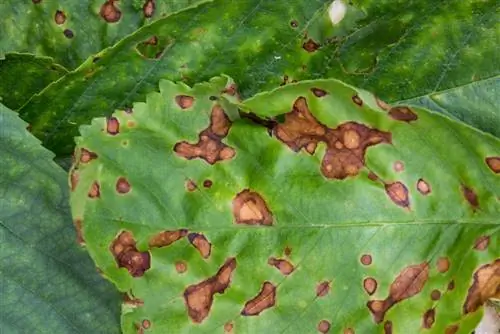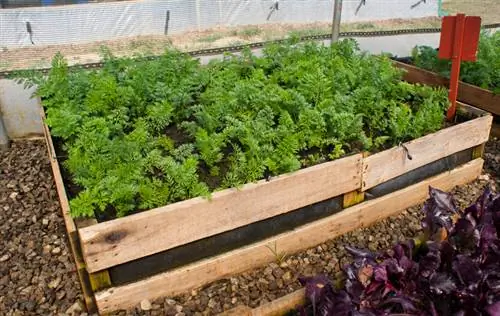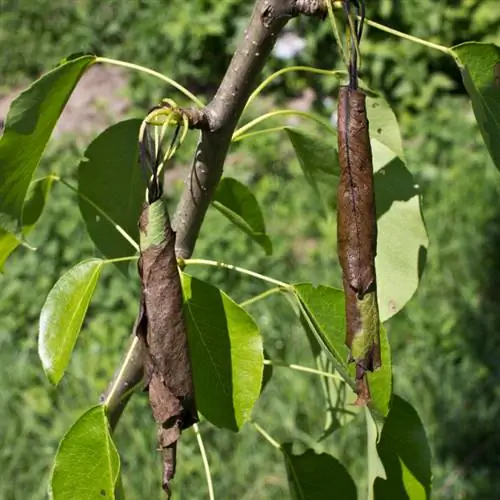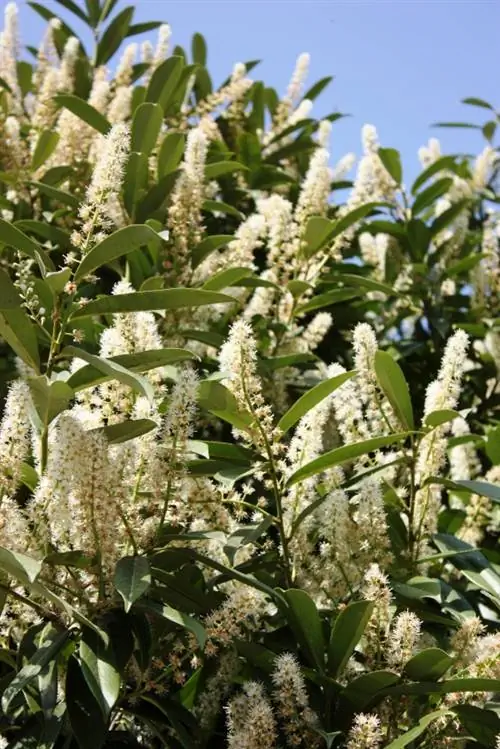- Author admin [email protected].
- Public 2023-12-16 16:46.
- Last modified 2025-06-01 06:02.
Shotgun disease is a fungal plant disease that primarily affects Prunus plants such as cherries, plums, peaches and cherry laurel. Read how you can recognize the dangerous infection in good time and fight it sustainably.
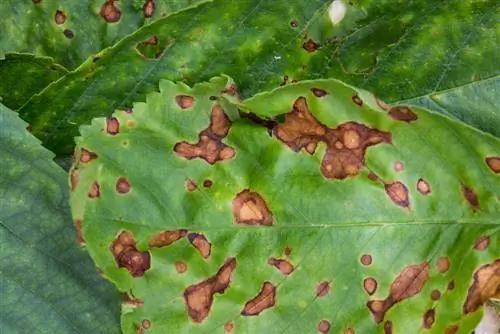
How to combat shotgun disease in plants?
Shotgun disease is a fungal infection that primarily affects Prunus plants such as cherries and plums. To combat this, we recommend heavy pruning, regular spraying with horsetail broth or copper-clay preparations and site-appropriate planting for prevention.
- Shotgun disease is a fungal plant disease that primarily affects Prunus plants.
- It initially appears on perforated leaves, but also attacks shoots and branches.
- To combat this, severe pruning is necessary, and in spring a spray with horsetail broth or preparations based on copper or clay.
- The disease mainly occurs after a cool and wet spring.
What is shotgun disease?
Due to the leaves appearing to be full of holes (which gave the disease its name), many hobby gardeners initially suspect a pest infestation. In fact, shotgun disease is a fungal plant disease caused by the ascomycete fungus Wilsonomyces carpophilus (also: Stigmina carpophila).
This mainly occurs after a damp and cool spring, as the pathogen is spread by, among other things, rain and the finest water droplets (such as those that appear in fog). Initial infection of young leaves and shoots is particularly common in May and June, whereas from around July older parts of the plant are only rarely infected due to their greater resistance - especially since the weather conditions are no longer ideal for the fungus in summer anyway.
In damp and rather cool summers, however, the new infection of young shoots continues into autumn. Even after the autumn leaf fall, late infections are still possible, which usually only become apparent in the following spring. The fungus hibernates on and in the plant, penetrates deep into the tissue and causes numerous problems - including the death of the affected trees.
Damage and course of the disease

These symptoms typically occur in affected trees:
- initially round, reddish-brown spots on the leaves
- often have red border
- Stains can also appear transparent or yellowish
- develop into black pustules as they progress
- and later to reddish-rimmed holes
- Leaves look literally full of holes
- Leaves eventually dry up and fall off
- infected trees are more or less bare at the beginning of summer
In addition to the leaves, other parts of the plant such as shoots and branches are often affected. Here an infection manifests itself through gum flow or cancerous growths. The latter mainly occur on older trees and show a defensive reaction on the part of the plant. Any fruits are also infected, but they soon dry up or rot and are dropped prematurely.
The fungus overwinters on infected plants, primarily on
- already infected shoots and branches
- on old, infected leaves
- in fruit mummies
From here it spreads the following spring on new shoots and young leaves. Over time, not only does stunted growth and reduced production of flowers and fruits occur, entire shoots and branches die - until finally the entire plant can no longer withstand the disease and dies.
Commonly affected plants
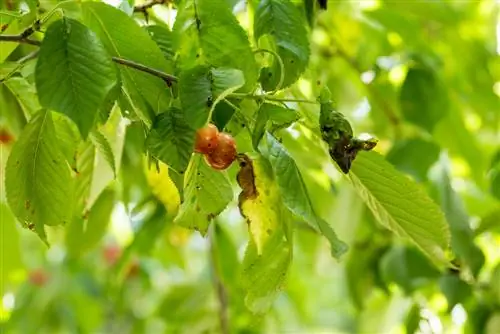
Cherries are particularly often affected by shotgun disease
Stone fruit trees are particularly often affected by shotgun disease, especially
- Sweet and sour cherries
- Plums and damsons
- Mirabelle plums
- Almonds
- Peaches and nectarines
- Apricots
In addition, infection is an ornamental tree, mainly on other Prunus species such as
- Cherry Laurel
- Ornamental cherries
- Ornamental plums
as well as hydrangeas and peonies probably. When it comes to houseplants, palm trees such as the Kentia palm are particularly at risk.
Excursus
Confusion with bacterial burn
The so-called bacterial blight occurs particularly on older stone fruit trees and is quickly confused with shotgun disease due to the similar damage caused. Here, too, there are leaf holes similar to shotgun blasts, but the tree bark is typically characterized by sunken, blackish injuries. In the spring there is a rubber flow from these. However, the pathogen here is not a fungus, but a bacterium called Pseudomonas syringae pv. morsprunorum. As with shotgun disease, it is controlled by heavy pruning, but fungicides are ineffective.
Fighting shotgun disease in the hobby garden
There are two possible periods of the year when infection with shotgun disease is possible. Since the fungus prefers a moist and cool climate, the first wave of the disease begins in spring and the second in autumn - here often only after the leaves have fallen, because then the tiny fungal spores have enough opportunities to invade. Once they have penetrated the trees, the fungi destroy the buds that have already been planted for next year. With the onset of winter they finally retreat deep into the interior of the plant.
In view of this life cycle, it is clear that active control of the pathogen makes sense, especially in spring and autumn. While you attack the fungus at the beginning of the shoots with sprays - if possible organic in the hobby garden - cut back infected parts of the plant vigorously in autumn. In this section we will explain to you how best to proceed and which remedies work.
Cut back affected plant parts
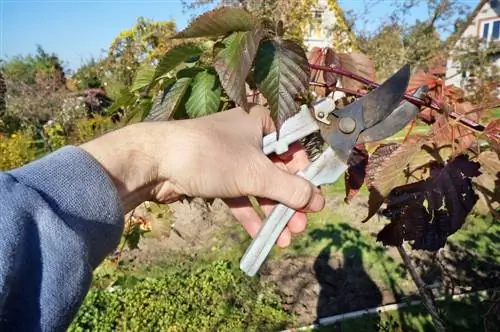
Infected plant parts should be removed and disposed of
The first step in combating shotgun disease is always a vigorous pruning, in which you cut all infected leaves and all diseased shoots and branches back to he althy wood.
- cut away all plant parts showing signs of disease
- sweep up all leaves from the ground
- cut off any diseased leaves remaining on the tree
- Removing fruit mummies
- Do not compost cuttings, dispose of them with household waste or burn them
In addition, regular thinning cuts are useful as a preventive measure in order to prevent another outbreak. Loose bushes and crowns dry out more quickly after a rainstorm and thus offer less surface area for the fungus to attack.
Tip
If possible, avoid planting cherry laurel (and other endangered trees) under taller trees. The dripping rainwater promotes infection, whereas a sunny and airy location is better for prevention.
Make your own spray - What really helps
A home-made spray that is effective against shotgun disease is based on the fungicidal effect of field horsetail. For plants that were diseased the previous year, start spraying undiluted horsetail broth in March - before budding - and continue this every 14 days until flowering begins.
Recipe for making horsetail decoction:
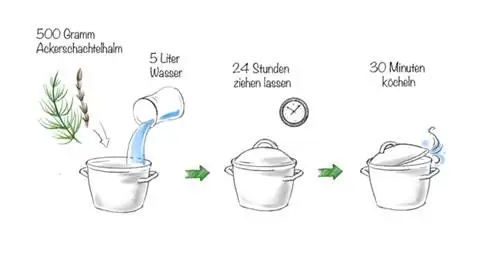
- Crush 500 grams of fresh field horsetail
- alternatively use 150 grams dried
- Soak in five liters of water for 24 hours
- then simmer on a low heat for half an hour
- let it cool down
- strain out the coarse ingredients
- fill into a squeeze bottle and use fresh
The broth described also works very well against other fungal diseases, such as mildew. Used for prevention, dilute the brew in a 1:5 ratio with soft water. If you don't want to prepare it yourself, you can buy a ready-made herbal extract from a specialist store.
Nettle manure, on the other hand, is not suitable for combating the fungal disease, but can be used preventatively to strengthen plants.
Fungicides permitted in home and hobby gardens - useful or not?
There are only a few fungicidal preparations available for home and hobby gardens. Biologically effective agents based on clay or copper, which are also used in organic farming, are available from specialist retailers. Only if these do not work should you use an approved fungicide. The Celaflor Pilzfrei Ectivo preparation is suitable, which you can use between March and April both for diseased plants and for prevention. However, their use needs to be carefully considered, because chemical pesticides pose considerable risks:
- Introduction of toxic substances into the environment
- Killing beneficial insects and other important garden creatures
- Petition of toxic substances into groundwater
- Disruption of ecological balance
In principle, caution is advised, because the list of substances permitted for private use is getting shorter and shorter. You must also ensure that you only use these fungicides in accordance with their approval for the permitted plant species and against the fungal diseases described. The reason for this restriction is to prevent possible resistance of pathogens to carelessly used agents. In any case, you will do at least as well with the preventative measures described as well as a spray with horsetail broth, clay or copper - just without the disadvantages of toxic pesticides.
Effectively prevent shotgun disease
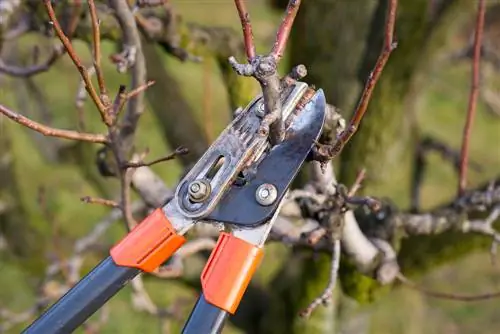
Regular pruning prevents shotgun disease
“Avoid a stand that is too close! Air must be able to circulate between the plants!”
Since shotgun disease is difficult to control once it has broken out, preventive measures are the best choice. The means and maneuvers described here are useful not only in the fight against these, but also against other fungal diseases in fruit trees.
- Rain protection: Since infection occurs through rain, it can be prevented using rain protection. Therefore, in the spring, before flowering, install a rain cover wherever possible.
- Adequate ventilation: Although light and air cannot prevent infection in cases of doubt, they do make it less likely due to the plant's higher resistance. Therefore, when planting, pay attention to a suitable location and sufficient planting distances (follow the recommendations!).
- Winter pruning: Prune trees regularly in winter and, in particular, consistently remove dry branches, old leaves and fruit mummies.
It also makes sense to strengthen the defenses of the trees from the moment they sprout with regular watering or spraying with horsetail tea. Spraying with wetting sulfur also has a preventative effect. This is a very finely ground sulfur powder that dissolves very well in water.
Spraying with network sulfur - Here’s how it works:
- monthly from March until flowering (for the last time in June)
- safe for bees, but very strong smell
- harmful to ladybirds, predatory mites and predatory bugs (beneficial insects!)
- Dissolve 20 to 40 grams of potassium sulfite (net sulfur) in 10 liters of water
- Liver of sulfur (consists of potassium carbonate - potash - and sulfur) is also very suitable
- add some soft soap as an adhesive
- undiluted tops
- do not spray in strong sunlight
Planting resistant varieties
Below you will find a list of fruit varieties that are largely resistant (i.e. particularly resistant) to shotgun disease. These are primarily old varieties, some of which were already in cultivation in the 19th century. But be careful: Planting insensitive varieties does not mean that the disease cannot break out. In addition to choosing a variety, you should also pay attention to targeted prevention (selection of location, planting distance, rain protection).
| Cherries | Plums/damsons | Peaches |
|---|---|---|
| ‘Abel’s Late’ | ‘Cacaks Beautiful’ | ‘Red Ellerstädter’ |
| ‘Gerema Weichsel’ | ‘Bühler Frühpwetschge’ | ‘Formerly Alexander’ |
| ‘Hausmüller’s medium thickness’ | ‘Katinka’ | ‘Revita’ |
| ‘Altenburg Melon Cherry’ | ‘Hanita’ | ‘Amsden’ |
| ‘Büttner’s Red Cartilage’ | ‘Dixired’ | |
| 'Querfurter Königkirsche' ('Königskirsche type Gatterstedt') |
Excursus
With onions and garlic against shotgun disease
Many gardeners plagued by shotgun disease swear by cultivating garlic and/or onions on the cuttings of particularly affected trees. These have antiseptic ingredients that are intended to reduce the risk of infection. Alternatively, you can simply spray or water your fruit trees with garlic or onion decoction as a preventive measure.
Frequently asked questions
Are fruits affected by shotgun disease still edible?
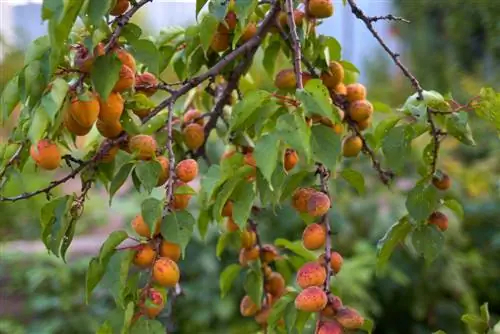
The fruits of such a diseased tree should not be eaten
If a tree is affected by shotgun disease, the fruits are usually also affected. This is shown by dark brown, sunken scabs, which have a significant negative impact on the taste and also contain fungal toxins. People with a fungus or penicillin allergy should therefore particularly refrain from eating or processing infected fruits. However, infected fruit is usually discarded before it ripens anyway.
Be careful when spraying with pesticides: You have to wait a few weeks (between 14 days and four weeks depending on the agent used) until the sprayed fruit can be harvested and approved for consumption.
What to do if the cherry laurel is attacked by shotgun disease every year?
Shotgun disease is very stubborn and difficult to combat; sometimes it appears every year - despite all the precautionary measures. Here, especially with trees that tolerate pruning such as cherry laurel, only a radical pruning will help in order to completely eliminate all pathogens. This ornamental tree in particular recovers very quickly and sprouts again he althy and strong. However, other plants that are repeatedly affected by shotgun disease - such as the cherry - should be cleared and replaced with a resistant variety.
Does homeopathy help against shotgun disease?
In fact, there are homeopathic elixirs (for example from Neudorff) that were specifically developed to strengthen plants' resistance to fungal diseases. However, these cannot be used directly to combat shotgun disease as they are ineffective against it. In general, the benefits of homeopathy are highly controversial, as all scientific studies do not confirm an effect that goes beyond that of a placebo effect. Therefore, you are likely to be much more successful with tried and tested home remedies such as home-made nettle manure, as they actually contain active ingredients.
When is the best time for a spray?
An injection only works for shotgun disease if it is carried out early enough. The first application takes place in spring when budding begins, followed by two further sprayings at intervals of around ten to 14 days. On the day of the spraying, the weather should be frost-free and dry, and there should be no wind - only then will the active ingredients get to where they are supposed to go.
Tip
Prevention is also helpful not to cultivate fruit trees and cherry laurel near a lawn sprinkler or similar. Watering - for example in very dry weather - should always be given directly to the tree disc and never over the leaves.

